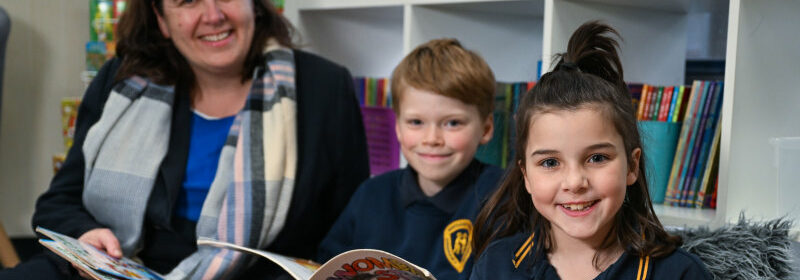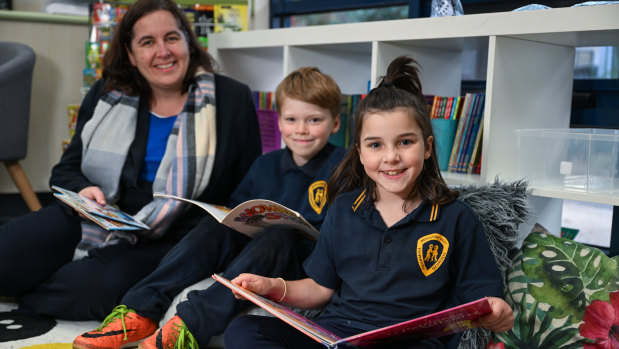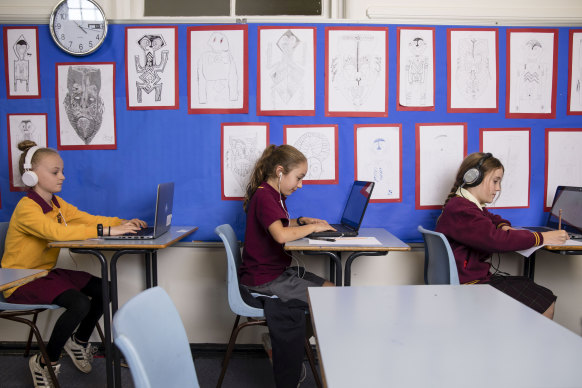Some students are borderline illiterate when they reach high school. Experts can’t agree on how to fix it

Save articles for later
Add articles to your saved list and come back to them any time.
Too many teachers feel unprepared about teaching reading comprehension and use “ad hoc” and inconsistent strategies, new research has found.
Experts said the inconsistent approach to teaching reading in the early years risked leaving many students borderline illiterate when they reach secondary school.
Bentleigh West Primary School Principal Sarah Asome and grade 2 students (left to right) Oliver Cowen and Essie Barker.Credit: JOE ARMAO
In Elementary Teachers’ Perspectives on Teaching Reading, a national study by La Trobe University examining teachers’ beliefs on how children develop reading comprehension skills in primary school, researchers found teachers used ad hoc practices to teach reading comprehension and often relied on their own personal research.
The study, which surveyed teachers across government, independent and Catholic sectors, also found there was no uniformity on how much time should be given to different tasks relating to reading comprehension and that there was a proliferation of commercial reading programs being used at schools, which experts said had “varying levels” of being evidence-backed.
In 2022, year 9 students’ NAPLAN reading results slipped to the lowest on record, with 13.5 per cent not reaching the national minimum standard. But Victorian Year 3 students ranked the strongest in the country when it came to reading.
Bentleigh West Primary School principal Sarah Asome made a shift to evidence-based literacy instruction about nine years ago. Her school has since seen a huge lift in reading, writing and spelling.
They invested in professional development in literacy and explicit teaching for both new and experienced staff. They now teach systematic phonics, grammar and vocabulary as well as morphology. Synthetic phonics teaches children the 44 sounds, or phonemes, in the English language and the letter combinations that make them. It breaks written language down into small and simple components. Morphology is the study of words and their parts.
Students have multiple exposures to content and learn from decodable texts in the early years.
She said the switch also helped identify students who were having difficulties and intervene early, leading to a decrease in behavioural issues.
Lead author of the report Reid Smith, co-authored with Edith Cowan University’s Lorraine Hammond, said the 284 Australian primary school teachers surveyed held a “wide range of beliefs about reading instruction, some of which are in direct opposition to each other”.
“We don’t have a common idea of what it means to teach reading comprehension, and we don’t have a common set of beliefs on the best ways to help our teachers to develop reading,” he said.
How to teach reading is highly contested in Australia, and he said there was a need for a more consistent evidence-based approach to initial teacher education.
Co-author La Trobe School of Education cognitive psychology professor Pamela Snow said there was a “very high level of variability” in the extent that teachers felt unprepared by their university education to support students’ reading comprehension skills.
Snow said reading was a “biologically secondary skill”, which meant it wasn’t learned purely through immersion like oral language skills. She said students should be able to “decode”, or have knowledge of letter-sound relationships, by Year 2.
In 2022, year 9 students’ NAPLAN reading results slipped to the lowest on record. Credit: Dominic Lorrimer
“It’s not the job of parents to teach children how to read,” Snow said.
“It’s the job of schools to teach all children, regardless of … their level of socio-economic advantage.”
She said it was a “public health imperative” that children became proficient readers through exposure to high-quality instruction, particularly in the first three years of school.
Lecturer of primary language and literacy Dr Linda Gawne agreed decoding was important, and had to be explicit and systematic but said they also needed an integrated approach to reading, as not all students learned the same way.
“It’s an extremely complex field and even academics can’t agree,” she said.
She said in Victoria, schools can choose which approach to literacy best suits them and disagreed there should be one mandated approach. She said the teachers who were surveyed had their initial training in a range of universities and had been teachers for varying amounts of time, some may need to upskill after 20 years, with dramatic changes in reading over time.
Gawne said being prescriptive could be counterproductive, considering Victoria’s good data results.
Australian Education Research Organisation chief executive Jenny Donovan said too many Australian students started high school without basic literacy skills.
“Teaching reading in ITE leaves a lot to be desired, there are very few institutions that are doing it well to date,” she said.
Improving initial teacher education is a focus of the Teacher Workforce Shortage Roundtable, which includes literacy and numeracy teaching strategies. A report is due on June 30, which will be considered by ministers in July.
Minister for Education Jason Clare said many teachers told him they felt unprepared for the classroom when they left university.
“We have to do a better job of preparing future teachers to teach literacy and numeracy and manage difficult classrooms,” she said.
The government is investing $5 million in evidence-based micro-credentials in classroom management, explicit teaching and phonics.
A Department of Education spokesperson said it provided advice, resources, and professional learning to support teachers to deliver the best education.
The Victorian Budget 2022-23 invested $11.3 million to strengthen the early literacy assessment suite to include an increased focus on phonics, as well as professional learning to support teachers in using these phonics assessment tools.
The federal government funds a phonics check and literacy hub, which aims to ensure that students struggling with learning to read are identified early using evidence-based assessment tools and resources.
Get the day’s breaking news, entertainment ideas and a long read to enjoy. Sign up to receive our Evening Edition newsletter here.
Most Viewed in National
From our partners
Source: Read Full Article

